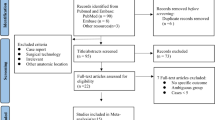Abstract
Optic canal invasion by tuberculum sellae meningiomas (TSMs) has been reported, but the characteristics of invasion remain unclear. This study was performed to clarify the incidence and characteristics of optic canal invasion by TSM and to determine whether optic canal invasion could be predicted preoperatively by magnetic resonance imaging (MRI). Between February 2002 and August 2014, 31 patients with TSM underwent tumor resection in our institute. In all cases, the optic canal was explored to identify any tumor invasion. We classified the characteristics of optic canal invasion from intraoperative findings. Invasion was classified into four types: type 1: no invasion; type 2: secondary invasion; type 3: partial wall invasion (two subtypes); and type 4: invasion into the supero-medial-inferior walls of the optic canal. Thirty of 31 cases showed optic canal invasion. Of these 30 cases, 9 (30 %) showed bilateral optic canal invasion. The most common finding was type 1 (23 sides). Among cases with optic canal invasion (39 sides), type 4 was the most common pattern (17 sides), followed by type 3-infero-medial (13 sides), type 2 (5 sides), and type 3-supero-medial (4 sides). Blinded prediction of tumor invasion was accurate in 61 % of cases, but characteristics of tumor invasion were undeterminable from preoperative MRI. In conclusion, optic canal invasion was frequently seen in our consecutive series of TSM, characteristics of which were unpredictable preoperatively. Neurosurgeons should be aware of the high incidence and variety of optic canal invasion in planning strategies for TSM treatment.



Similar content being viewed by others
References
Andrews BT, Wilson CB (1988) Suprasellar meningiomas: the effect of tumor location on postoperative visual outcome. J Neurosurg 69(4):523–528
Arai H, Sato K, Okuda, Miyajima M, Hishii M, Nakanishi H, Ishii H (2000) Transcranial transsphenoidal approach for tuberculum sellae meningiomas. Acta Neurochir (Wien) 142(7):751–756, discussion 756-757
Bowers CA, Altay T, Couldwell WT (2011) Surgical decision-making strategies in tuberculum sellae meningioma resection. Neurosurg Focus 30(5), E1
Chi JH, McDermott MW (2003) Tuberculum sellae meningiomas. Neurosurg Focus 14(6), e6
Chokyu I, Goto T, Ishibashi K, Nagata T, Ohata K (2011) Bilateral subfrontal approach for tuberculum sellae meningiomas in long-term postoperative visual outcome. J Neurosurg 115(4):802–810
Cook SW, Smith Z, Kelly DF (2004) Endonasal transsphenoidal removal of tuberculum sellae meningiomas: technical note. Neurosurgery 55(1):239–244, discussion 244-246
Couldwell WT, Weiss MH, Rabb C, Liu JK, Apfelbaum RI, Fukushima T (2004) Variations on the standard transsphenoidal approach to the sellar region, with emphasis on the extended approaches and parasellar approaches: surgical experience in 105 cases. Neurosurgery 55(3):539–547, discussion 547-550
de Divitiis E, Cavallo LM, Esposito F, Stella L, Messina A (2007) Extended endoscopic transsphenoidal approach for tuberculum sellae meningiomas. Neurosurgery 61(5 Suppl 2):229–237, discussion 237-238
de Divitiis E, Esposito F, Cappabianca P, Cavallo LM, de Divitiis O (2008) Tuberculum sellae meningiomas: high route or low route? A series of 51 consecutive cases. Neurosurgery 62(3):556–563, discussion 556-563
Dusick JR, Esposito F, Kelly DF, Cohan P, DeSalles A, Becker DP, Martin NA (2005) The extended direct endonasal transsphenoidal approach for nonadenomatous suprasellar tumors. J Neurosurg 102(5):832–841
Fahlbusch R, Schott W (2002) Pterional surgery of meningiomas of the tuberculum sellae and planum sphenoidale: surgical results with special consideration of ophthalmological and endocrinological outcomes. J Neurosurg 96(2):235–243
Fatemi N, Dusick JR, de Paiva Neto MA, Malkasian D, Kelly DF (2009) Endonasal versus supraorbital keyhole removal of craniopharyngiomas and tuberculum sellae meningiomas. Neurosurgery 64(5 Suppl 2):269–284, discussion 284-286
Gardner PA, Kassam AB, Thomas A, Snyderman CH, Carrau RL, Mintz AH, Prevedello DM (2008) Endoscopic endonasal resection of anterior cranial base meningiomas. Neurosurgery 63:36–52, discussion 52-34
Goel A, Muzumdar D, Desai KI (2002) Tuberculum sellae meningioma: a report on management on the basis of a surgical experience with 70 patients. Neurosurgery 51(6):1358–1363, discussion 1363-1364
Gregorius FK, Hepler RS, Stern WE (1975) Loss and recovery of vision with suprasellar meningiomas. J Neurosurg 42(1):69–75
Grisoli F, Diaz-Vasquez P, Riss M, Vincentelli F, Leclercq TA, Hassoun J, Salamon G (1986) Microsurgical management of tuberculum sellae meningiomas. Results in 28 consecutive cases. Surg Neurol 26(1):37–44
Jallo GI, Benjamin V (2002) Tuberculum sellae meningiomas: microsurgical anatomy and surgical technique. Neurosurgery 51:1432–1439, discussion 1439-1440, discussion 1439-1440
Liu JK, Das K, Weiss MH, Laws ER, Couldwell WT (2001) The history and evolution of transsphenoidal surgery. J Neurosurg 95(6):1083–1096
MacCarty CS, Taylor WF (1979) Intracranial meningiomas: experiences at the Mayo Clinic. Neurol Med Chir (Tokyo) 19(7):569–574
Mahmoud M, Nader R, Al-Mefty O (2010) Optic canal involvement in tuberculum sellae meningiomas: influence on approach, recurrence, and visual recovery. Neurosurgery 67(3 Suppl Operative):108–118, discussion 118-119
Nakamura M, Roser F, Struck M, Vorkapic P, Samii M (2006) Tuberculum sellae meningiomas: clinical outcome considering different surgical approaches. Neurosurgery 59(5):1019–1028, discussion 1028-1029
Nozaki K, Kikuta K, Takagi Y, Mineharu Y, Takahashi JA, Hashimoto N (2008) Effect of early optic canal unroofing on the outcome of visual functions in surgery for meningiomas of the tuberculum sellae and planum sphenoidale. Neurosurgery 62(4):839–844, discussion 844-846
Pamir MN, Ozduman K, Belirgen M, Kilic T, Ozek MM (2005) Outcome determinants of pterional surgery for tuberculum sellae meningiomas. Acta Neurochir (Wien) 147(11):1121–1130, discussion 1130
Sade B, Lee JH (2009) High incidence of optic canal involvement in tuberculum sellae meningiomas: rationale for aggressive skull base approach. Surg Neurol 72:118–123, discussion 123
Schick U, Hassler W (2005) Surgical management of tuberculum sellae meningiomas: involvement of the optic canal and visual outcome. J Neurol Neurosurg Psychiatry 76(7):977–983
Wang Q, Lu XJ, Li B, Ji WY, Chen KL (2009) Extended endoscopic endonasal transsphenoidal removal of tuberculum sellae meningiomas: a preliminary report. J Clin Neurosci 16(7):889–893
Acknowledgments
Pree Nimmannitya is supported by a fellowship from Takeda Science Foundation.
Author information
Authors and Affiliations
Corresponding author
Ethics declarations
Conflict of interest
The authors have no conflicts of interest to declare.
Rights and permissions
About this article
Cite this article
Nimmannitya, P., Goto, T., Terakawa, Y. et al. Characteristic of optic canal invasion in 31 consecutive cases with tuberculum sellae meningioma. Neurosurg Rev 39, 691–697 (2016). https://doi.org/10.1007/s10143-016-0735-6
Received:
Revised:
Accepted:
Published:
Issue Date:
DOI: https://doi.org/10.1007/s10143-016-0735-6




